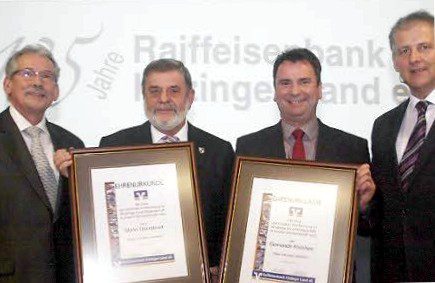All the enjoyment under one roof

Erich schmitt experienced the development of the raiffeisen banks in the district of kitzingen at first hand. When he was elected chairman of the board in 1972, the previously independent raiffeisen facilities in rodelsee and kleinlangheim had already been merged with groblangheim. A new building was not to be erected in groblangheim; the bank decided to partially rebuild the former ten barn. It was the time when the merchandise business that had existed until then was abandoned due to competition. The raiffeisenbank kitzinger land looked back on these and many other stories at its 135th anniversary celebration, which took place on friday evening in groblangheim.
"There were no cutbacks until the merger with obernbreit", erich schmitt recalls, and also names the reason: the money disbursed was to remain in the villages. First, there was the rough question of which raiffeisenbank groblangheim should merge with: wiesentheid or kitzingen. However, the choice fell on obernbreit, which presented itself as similarly well positioned. Erich schmitt still led the negotiations for the unification, but then he did not stand for re-election in 1999 after 27 years as chairman of the board of directors. "The important thing for me was that it continued. I was a cooperative member through and through."
For schmitt, the year that has now almost come to an end was certainly an important one – as bank director albrecht hack explained at the ceremony, it was the international year of cooperatives. For the bank, this was also a reason to celebrate the unusual 135th anniversary of its founding. "The roots lie in groblangheim, when 85 men and women joined on 15. December 1877 did justice to the spirit of new movements at the time", hack outlined the basic idea of the time: what one person can't do, many can. Today, raiffeisenbank kitzinger land has 3680 members.
For alexander buchel, the value of cooperatives lies in their intangible assets – as keynote speaker, the member of the executive board of the bavarian cooperative association named solidarity, regionality and cooperative spirit as the most important building blocks. 1877 had certainly not been an easy time, given the economic stagnation, because the social security systems had only been introduced later. Some burghers followed friedrich wilhelm raiffeisen's idea and founded the credit union, since no help could be expected from auben. "The cooperative form was not chosen without reason, because it meant that concrete problems could be alleviated together." It was mostly about small loans.
The bank had done well with this decision for 135 years, coping very well with two world wars, two economic reforms, several forms of government, and the division of germany. The bank always kept up with the times and joined forces with other raiffeisen loan societies – but never at the expense of regional development. Thanks to the cooperative banks as partners of the economy, the national economy has coped far better with crises than is the case in other countries, even though their entrepreneurs have also encountered difficulties.
Buchel raised the question of whether banks were still desirable in view of the increasing number of banks coming from berlin and brussels, because big banks and raiffeisen banks were treated equally. This put a strain on the mainly regionally active SME banks, even though they had ensured stability in the past.
Actively confronting poverty
The idea behind the plan to found a loan association was to combat poverty by forming solidarity cooperatives, reported bank director reinhold weber. It is particularly noteworthy that seven women were among the founding members, although they did not have the right to vote at that time. The as "association was incorporated into the cooperative system in 1919. It granted loans of between 30 and 2000 reichsmarks to pay for purchases and repairs. "This has remained the case until today – only the amounts are higher", weber remarked. In the loan association kleinlangheim, founded in 1909, there had been higher loans, because there was a little more prosperity there. After the mergers, the business volume was twelve million marks and reached a value of 87 million marks by 2001. When the bank merged to form raiffeisenbank kitzinger land in 2003, its business volume was already 140 million marks. Weber's look back illustrated the courage of the people of the region to face economic hardship in a community of solidarity.
With this impressive success story, district administrator tamara bischof felt that 135 years was reason enough to celebrate. "After a period of doubt, the cooperative model is now in again, because it shows that cooperatives can work." Unlike big banks, savings banks and cooperative banks in particular are still rooted in the countryside as partners of municipalities and companies.
Hack and weber had already honored 72 members for 25, 50 and 60 years of membership. During the ceremony, the mayors of rodelsee, burkhard klein, and obernbreit, bernhard bruckner, were awarded certificates for many years of loyalty. Rodelsee has belonged to today's bank for 80 years, obernbreit already for 90 years. "Both villagers recognized even then that striving forward together is the future", noted hack.
The celebration was musically framed by the kaffeehausensemble eitel with soprano Eva Hajkova endres.
